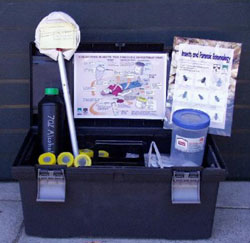Forensic Entomology is Not For the Faint-Hearted!
By Chris Williams on November 12, 2013.
 Forensic science is a popular theme for TV shows lately. In the old days, we had “Quincy.” Now you can choose from many shows that offer the nitty-gritty, gruesome details of crime scene investigation; to name a few: “CSI,” “Forensic Files,” “Investigative Reports,” and “The New Detectives.” Sometimes these shows feature forensic entomology or the science of using insects to solve crimes or resolve legal cases.
Forensic science is a popular theme for TV shows lately. In the old days, we had “Quincy.” Now you can choose from many shows that offer the nitty-gritty, gruesome details of crime scene investigation; to name a few: “CSI,” “Forensic Files,” “Investigative Reports,” and “The New Detectives.” Sometimes these shows feature forensic entomology or the science of using insects to solve crimes or resolve legal cases.
Want your child to be a forensic entomologist when she grows up? Forensic entomologists are certified by the American Board of Forensic Entomologists and may belong to the North American Forensic Entomology Association. Forensic entomology is divided into three branches:

- medico-legal — insects infesting human remains,
- urban — infestations of buildings or gardens, and
- stored product pests – legal cases involving food contamination by insects.
For the most part, forensic entomologists study fly maggots, and often maggots on decaying bodies—not exactly a specialty for the weak of stomach. By identifying the maggots, they can apply what they know about the fly’s life cycle and habits and can pinpoint the time, and sometimes the location, of the death. Other insects infest a dead body as well, but blow flies are always the first on the scene, sometimes arriving to lay their eggs only an hour after death.
A forensic entomologist collects any fly eggs or larvae found on the corpse and identifies them. Sometimes this means waiting until they develop into adult flies. Once he (or she) knows the species of fly, he then knows how soon after death the fly is attracted to a body. He also knows how long it takes that fly to develop through various stages from egg to adult. He factors in data that may have slowed down or speeded up the fly’s development, such as variations in temperature and humidity, whether the body was exposed to air, or was buried, etc. Working backwards with expert knowledge, a forensic entomologist can pinpoint the approximate time of death.
It’s not always death and gore. Forensic entomologists often provide the expertise in lawsuits where insects are a factor.
Case Study
A family claimed that the steak they bought and cooked turned out to be full of maggots. They returned the cooked steak to the supermarket, full of wriggling larvae, and sued the store. A forensic entomologist on the case purchased a similar steak, added maggots, and cooked it to the family’s specifications. Every maggot dried and shriveled up during cooking. He testified in court that cooking the meat would have cooked the maggots as well. The supermarket won the case.